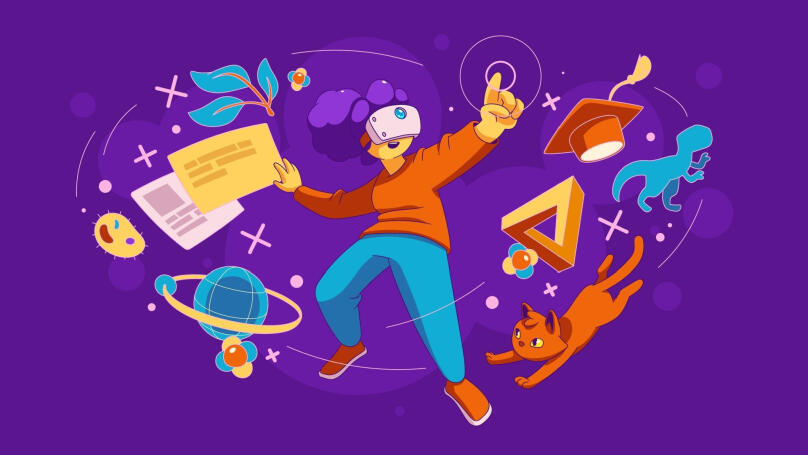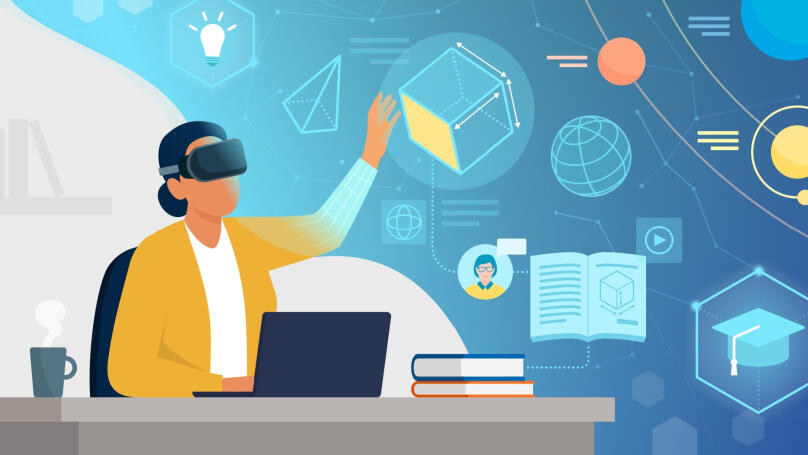Immersive Learning

What is Immersive Learning?
Immersive learning is a method that involves the use of artificial or specially modelled environments to fully immerse the learner in the educational process, for example, using virtual and augmented reality technologies. This strategy allows for better absorption of new information by eliminating distractions, making learning less boring and monotonous, and making lessons engaging and entertaining. It makes learning more productive, easy, and relaxed for students.
Immersive itself means being fully involved, it is the ability to take part in an action. For example, there is an immersive theatre in which the audience takes part in the performance together with professional actors. Therefore, the final is unknown and depends on each participant. The same principle guides the use of the immersive method in teaching. Moreover, literature, painting, and music also strive for immersiveness, i.e. involving a person in an artificially created world. It provides a specific effect of presence, community, and involvement in what is happening.
More About Immersive Learning in Education
In immersive learning, all students get engrossed in an interactive environment in which they obtain knowledge, skills, and abilities. However, the presence of virtual worlds and augmented reality elements is not the only principle of immersive learning. Equally important are:
- Spontaneity. The immersive method does not involve using a ready-made scenario so that students can express themselves in different ways in various activities, and the teacher's task is to create a trusting atmosphere and help students realise their potential.
- Interactivity. Learners gain new knowledge and skills by interacting with the environment using various tools and opportunities. It allows for realistic situations and better learning.
- Constant communication and keeping in touch. In immersive learning, it is imperative to interact with other students and provide support and assistance.
- No hierarchy. There are no rigid restrictions for students and teachers because there are no those who only teach and those who only learn. Everyone involved in the learning process acquires new knowledge and helps others learn it.
- Freedom of action. In the immersive method, students do not have a common goal; everyone chooses their area of activity and realises their potential as they see fit, and the teacher only supports students in their endeavours.
Thus, the immersive method keeps students engaged throughout the educational process and increases motivation, speed, and quality of learning.
Other Benefits of Immersive Learning

The benefits include:
1. Visibility
Virtual worlds allow for a closer look and scrutiny of various processes that are impossible or super difficult to study in real life. For example, in a digital environment, information about the work of human organs, the structure of various organisms, the design of all sorts of mechanisms, and so on is much more effectively learnt because contemporary technologies make it possible to reproduce even the most complex processes and phenomena visually.
2. Concentration and attention span
Thanks to total involvement in the process, immersive learning allows you to eliminate all distractions and external stimuli. It contributes to better absorption and focuses on education and developing skills such as focus, memory, and brain function.
3. Increased motivation to learn
You can significantly enhance the desire to learn because each student can simulate the environment and become fully immersed in the context, perform the tasks they like and progress in the areas they are most interested in.
4. Safety
Virtual reality allows you to learn new skills without serious risks, conduct scientific experiments and complex operations, and try your hand at various dangerous activities.
5. Personalised approach to learning
Immersive learning is initially based on a model that is primarily learner-centred. It allows everyone to learn at their own pace, study additional materials, immerse themselves in complex topics as much as possible, and consider the learners' interests, abilities, and needs, making immersive learning very similar to a person-centred approach.
However, immersive learning also has several drawbacks. For example, excessive use of virtual technologies during training may hinder the development of other equally essential abilities, such as empathy, communication skills, etc. That is why such technologies should be developed and used only by real professionals. Accordingly, immersiveness requires a highly qualified labour force and the most responsible specialists. Another disadvantage of virtual spaces related to security is also associated with this. It is necessary to protect all users from possible cyberspace risks related to data privacy.
Moreover, using fully immersive learning environments can lead to learners being absorbed in VR devices and gadgets rather than in the learning process. It can contribute to the deterioration of educational outcomes.
Types of Immersive Learning

Immersive learning can vary depending on the technology that realises full immersion. For example, immersive learning can include:
-
Virtual Reality
With the help of VR technologies, it is possible to recreate any space in digital form entirely, simulate various situations, act in roles not typical for oneself, and realise one's potential to the maximum. You can also go to the most inaccessible, remote places and even travel through time using a special headset, such as a helmet or glasses. Also, in the virtual world, users are as interested in sports as in real life. For example, they can ski, participate in races and tennis tournaments, learn other professions, and engage in scientific activities and experiments. Thus, the features of VR space provide total freedom of action and the right to an unlimited number of mistakes.
-
Augmented Reality
AR, or Augmented Reality Technology, allows you to transform the physical environment into a digital interface, adding new elements and expanding its capabilities. In essence, AR is an extension of the real world, but with the addition of virtual objects. For example, in the learning process, this technology is used for so-called "animated illustrations" when studying biology and other sciences. For this purpose, it is enough to point the smartphone camera at an illustration, and instead of two-dimensional pictures, you will see three-dimensional models of human organs.
-
Mixed Reality (MR)
The combination of augmented reality and virtual reality makes all interactions in the digital environment more realistic. It is also MR that allows physical objects and users to coexist in real-time. Thus, mixed reality is called the analogue of augmented reality, which combines the capabilities of a VR headset and superimposes other textures and images on the existing environment. It creates a new space where fully integrated virtual objects interact with real objects.
-
Three-Dimensional Learning
Three-dimensional visualisation and simulation of the environment immerses the user in an artificially created world and, like VR technology, opens additional possibilities for the user. For example, 3D learning can take place in a metaverse, which has a high potential precisely in the educational environment. Thus, the 3D method promotes more in-depth learning by combining virtual and augmented space. It is because of learning in a 3D environment that the most complete and detailed models of objects and phenomena get created, allowing us to visualise the most complex processes. Furthermore, you can conduct experiments and training in a safe and controlled environment in virtual labs and other augmented environments that are created to teach various practical skills.
An immersive learning system can turn the educational process into a real journey. Learners can interact with each other and with different characters, work through interesting cases and puzzles, and solve rebuses and riddles, thus mastering the most complex skills in a game format. Gamification also allows you to track your achievements and progress, compete with others and contend for the championship. Thus, learners gain new knowledge and skills more quickly and consolidate them in games and other entertaining tasks.
-
Simulations
Simulations allow you to experiment without fear of making mistakes and stay safe even under the riskiest conditions. For example, through immersive learning, you can learn to fly aeroplanes and other vehicles, build houses, design cars, and create inventions while honing your skills in a virtual space.
Immersive Learning vs Experiential Learning

As we have already understood, immersive learning involves acquiring new knowledge and skills in a digital environment using special equipment for virtual reality. It is closely related to the experiential learning theory based on trial and error. Accordingly, it is an empirical approach because you are best at learning new material if it gets tested by experience.
However, the immersive approach and the concept of experiential learning have significant differences. For example, immersive learning uses virtual and augmented reality technologies or all of them simultaneously. Therefore, immersive learning implies the inclusion of various devices, mobile phones, and other additional gadgets in the educational process. And in the case of experiential learning, the latest technologies may not be used at all. It is because the primary goal of immersive participation is to help learners express themselves and their talents and eliminate uncertainty and fear of making mistakes by learning in a safe and controlled environment, free from the risks necessarily present. Simultaneously, experiential learning involves helping students develop their problem-solving and decision-making abilities in real-life situations.
Additionally, the experiential approach does not contain game elements. At the same time, gamification is used in immersive education, and immersive education is based on dynamic learning, which, in turn, is carried out due to the active and continuous work of all participants in the process. Static mechanics characterises the experimental approach to the process of acquiring new knowledge.
In addition, the empirical method does not always maximise the thinking functions of learners. It is aimed, first, at the so-called goal setting and goal fulfilment, i.e. the generation of a specific goal and the development of an algorithm of actions, followed by the solution of specific tasks to achieve the primary goal. At the same time, immersiveness requires including all types of human thinking during the educational process and maximum involvement of thinking functions.
The most apparent difference between immersive and experiential learning is that the former is realised through complete and detailed implementation. In contrast, the latter is realised through the inclusion of a skill. However, it is almost impossible to determine which type of non-formal education is the most effective, impactful, and efficient. Each has several benefits; therefore, they must be combined to achieve quick and high learning outcomes.
Immersive Learning Examples

Immersive technologies enhance the learning experience and promote impactful learning. The most striking examples of using immersive learning prove this.
For example, the scientific VR game InMind2 allows you to study the processes occurring in the human body in detail. It is possible in the example of a virtual teenager named John. Chemistry, physiology, and anatomy students can explore how biological processes affect the formation of human personality and control the maturation changes in John's internal organs and body structure.
A similar app called Labster provides a safe environment to explore numerous technical disciplines called STEM, offering over one hundred types of virtual labs. Students can conduct their experiments and explore the principles of atomic structures, animal genetics, fermentation, etc. Labster's virtual reality is explicitly designed for experimentation and learning the basics of chemistry, physics, biology, and other sciences.
Thanks to the simulator HistoryMaker VR, everyone can move in time and be in the place of a famous historical figure. For example, you can try on the role of the first American feminist, Abigail Adams, President Abraham Lincoln, diplomat Benjamin Franklin and many other political figures. The management of Schell Games, the HistoryMaker developer, explained the history simulator's mission: "We wanted to create an app that not only allows you to learn but to experience history first-hand. With HistoryMaker VR, we hope to fill the knowledge gap and make learning history interactive and fun."
Moreover, you can also use VR to visit educational institutions virtually. For example, for career guidance purposes, the University of Michigan football team has created a virtual tour for prospective students that allows them to be in a huge stadium where athletes train. It became possible thanks to the use of special virtual reality glasses, which ensure the complete immersion of applicants in the environment of their future place of study.
In turn, the American company Lockheed Martin has developed a project allowing schoolchildren to travel to Mars! The developers even did it without a pricey and large-scale VR headset. They installed transparent 4K displays and switchable glass film directly on the windows of the school bus. These interactive displays depict the surface of Mars and allow children to explore another planet. The Lockheed Martin project aims to spark a genuine interest in space and a desire for children to explore.
Immersive technology is also used extensively at the Jackson School in Victoria, Australia. Virtual reality capabilities and the Oculus Rift headset are used for children with special needs to visualise learning materials more clearly. In this way, children with even the most severe disabilities can learn information quickly and easily. For example, children learn about planets, stars, and other celestial bodies in the virtual world. In addition, the digital space presents a safer and more comfortable environment for them.
Conclusion
Thus, immersive technologies are becoming an integral part of the educational process. Of course, their competent implementation involves using auxiliary devices and headsets, additional financial costs, and the involvement of highly qualified specialists and professional retraining of teachers. However, despite all the obstacles, virtual reality is becoming increasingly firmly integrated into everyday life. After all, in today's world, the ability to work with digital technology is becoming an increasingly essential skill that allows children to prepare for the future and try their hand at various activities. In time, immersive learning will revolutionise the world of education and will not leave even the most conservative representatives of traditional education indifferent.























